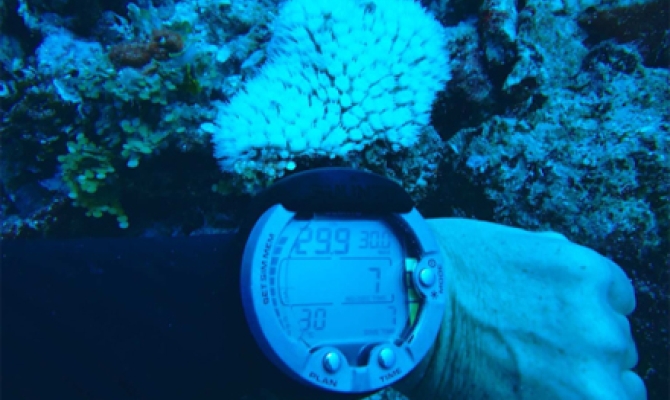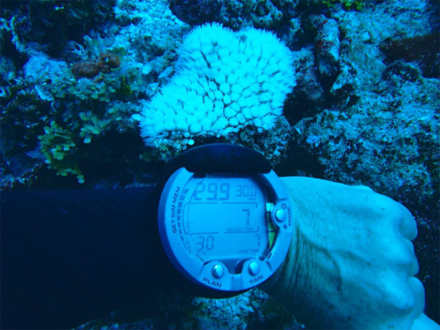
Biodiversity Conservation
While a recent survey of the reefs in Vava'u, Tonga has indicated generally healthy and well-stocked reefs, scientists involved in the study are also reporting observations of the first stages of a coral bleaching event. The Rapid Biodiversity Assessment or BIORAP survey, coordinated by the Secretariat of the Pacific Regional Environmental Programme (SPREP), at the end of February this year, found that about 1-3% of corals in some specific locations were showing some early indications of bleaching.

Due to increasing water temperatures, the US Government agency, National Oceanographic and Atmospheric Administration (NOAA) Coral Watch programme had previously announced a bleaching watch for Tonga in February 2014. The BIORAP team also recorded seawater temperatures rising in the last week of February to about 30.5 degrees celsius.
Most of the bleaching observed was between ten metres and the surface however, individually bleached coral colonies were observed up to depths of 30 metres in some places. A range of coral species was recorded as bleaching.
Corals bleach when the seawater temperature increases. Corals get their bright colours from algae (zooxanthellae), which live on the coral. These tiny plants also enable the coral to photosynthesise and produce food for the coral colony. The increased water temperature results in the zooxanthellae being released from the coral, leaving the coral bright white (bleached). As the coral has lost the plant component, it has also lost its food source and is under extreme stress to survive. However, corals may recover from bleaching events if seawater temperatures decrease sufficiently. Bleaching events affect many different areas of the marine ecosystem, including reef fish populations. Weakened coral reefs also mean reduced protection for shorelines.
The BIORAP team was surveying reefs and terrestrial ecosystems in the Vava'u group in support of conservation planning in Tonga. The Kingdom of Tonga is located north and slightly east of New Zealand, and east of Fiji in the Pacific, and the Vava'u group of islands is at about 18.6500o S.
The marine team was based on the Waitt Institute Scientific Platform to conduct the marine surveys of Vava'u as part of the BIORAP study with SPREP, Ministry of Lands, Environment, Climate Change, and Natural Resources, Waitt Foundation and Vava'u Environmental Protection Association VEPA.
The coral reef areas identified as bleaching sites will continue to be monitored and recorded for further analysis.
For more information, contact: sprep@sprep.org or Karen Stone - info@vavauenvironment.org

Due to increasing water temperatures, the US Government agency, National Oceanographic and Atmospheric Administration (NOAA) Coral Watch programme had previously announced a bleaching watch for Tonga in February 2014. The BIORAP team also recorded seawater temperatures rising in the last week of February to about 30.5 degrees celsius.
Most of the bleaching observed was between ten metres and the surface however, individually bleached coral colonies were observed up to depths of 30 metres in some places. A range of coral species was recorded as bleaching.
Corals bleach when the seawater temperature increases. Corals get their bright colours from algae (zooxanthellae), which live on the coral. These tiny plants also enable the coral to photosynthesise and produce food for the coral colony. The increased water temperature results in the zooxanthellae being released from the coral, leaving the coral bright white (bleached). As the coral has lost the plant component, it has also lost its food source and is under extreme stress to survive. However, corals may recover from bleaching events if seawater temperatures decrease sufficiently. Bleaching events affect many different areas of the marine ecosystem, including reef fish populations. Weakened coral reefs also mean reduced protection for shorelines.
The BIORAP team was surveying reefs and terrestrial ecosystems in the Vava'u group in support of conservation planning in Tonga. The Kingdom of Tonga is located north and slightly east of New Zealand, and east of Fiji in the Pacific, and the Vava'u group of islands is at about 18.6500o S.
The marine team was based on the Waitt Institute Scientific Platform to conduct the marine surveys of Vava'u as part of the BIORAP study with SPREP, Ministry of Lands, Environment, Climate Change, and Natural Resources, Waitt Foundation and Vava'u Environmental Protection Association VEPA.
The coral reef areas identified as bleaching sites will continue to be monitored and recorded for further analysis.
For more information, contact: sprep@sprep.org or Karen Stone - info@vavauenvironment.org